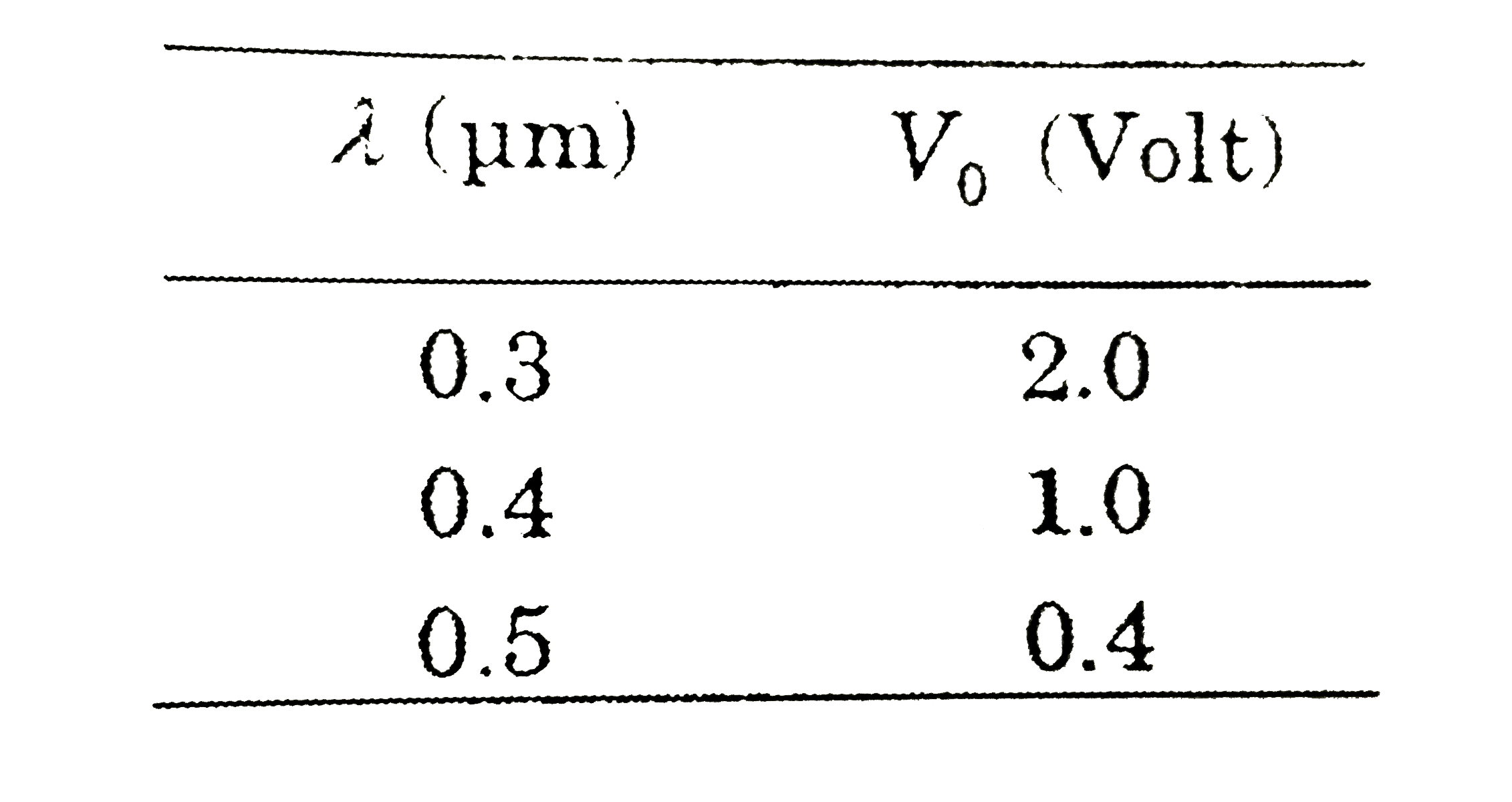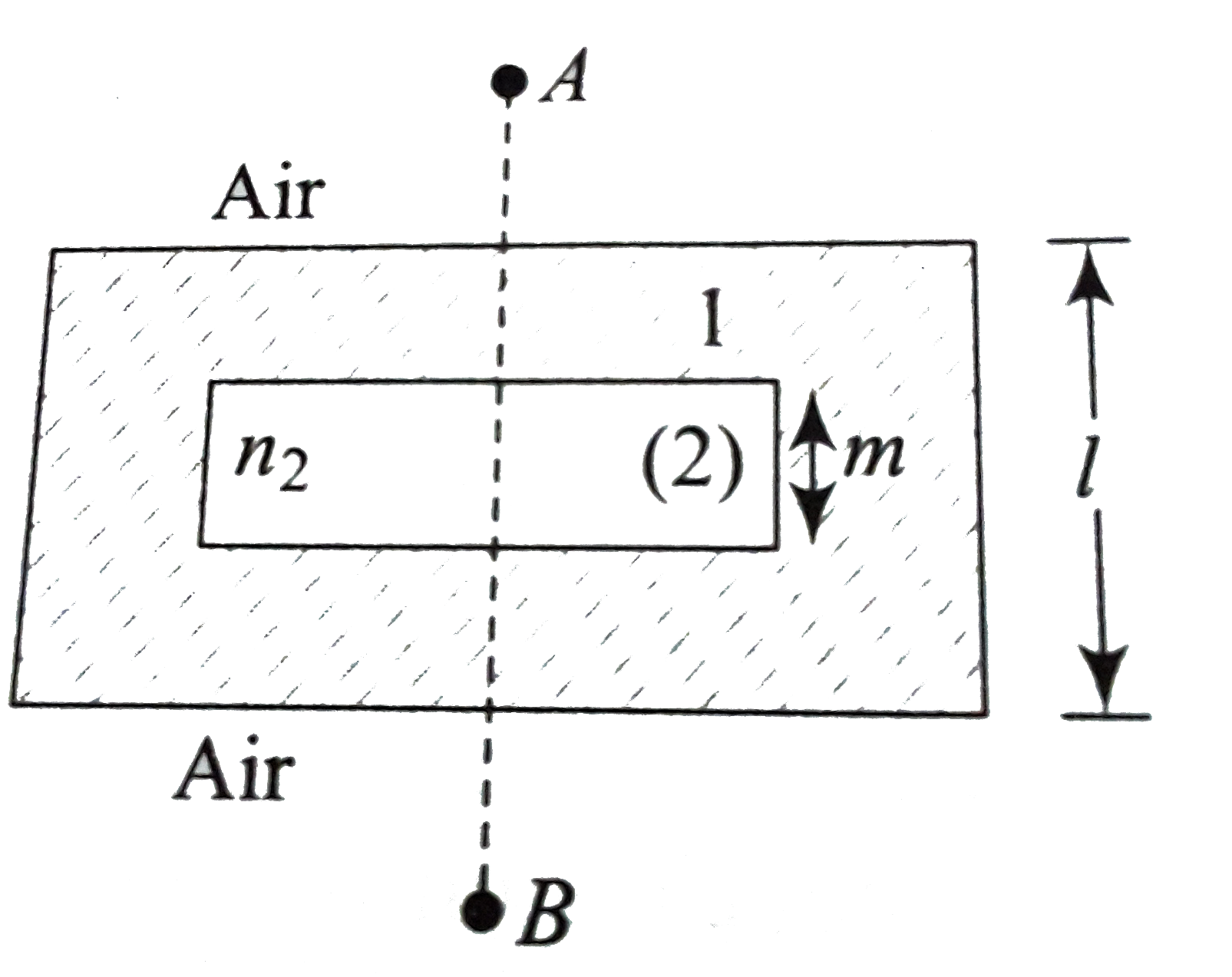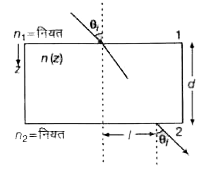A transparent slab of thickness d has a refractive index n(z) that increases with z. Here z is the vertical distance inside the slab, measured from the top. The slab is placed between two media with uniform refractive indices n1 and n2(>n1), θ0, from medium 1 and emerges in medium 2 with refraction angle θtwith a lateral displacement l.
Which of the following statement(s) is (are) true?

n1sinθi=n2sinθr
n1sinθi=(n2−n1)sinθr
l is independent of n2
l is fependent on n(z)
The correct Answer is:A, C, D
Step by step video & image solution for A transparent slab of thickness d has a refractive index n(z) that increases with z. Here z is the vertical distance inside the slab, measured from the top. The slab is placed between two media with uniform refractive indices n_(1) and n_(2)(gtn_(1)), theta_(0), from medium 1 and emerges in medium 2 with refraction angle theta_(t)with a lateral displacement l. Which of the following statement(s) is (are) true? by Physics experts to help you in doubts & scoring excellent marks in Class 12 exams.
Updated on:21/07/2023Topper's Solved these Questions
- JEE ADVANCEDBOOK - JEE ADVANCED PREVIOUS YEARCHAPTER - JEE ADVANCEDEXERCISE - PART-1 PHYSICS (SECTION 3 )
5 Videos
- JEE ADVANCEDBOOK - JEE ADVANCED PREVIOUS YEARCHAPTER - JEE ADVANCEDEXERCISE - PART I : PHYSICS (SECTION 1)
13 Videos
- JEE ADVANCEDBOOK - JEE ADVANCED PREVIOUS YEARCHAPTER - JEE ADVANCEDEXERCISE - PART-1 PHYSICS (SECTION 1 )
5 Videos
- JEE (ADVANCE) 2020BOOK - JEE ADVANCED PREVIOUS YEARCHAPTER - JEE (ADVANCE) 2020EXERCISE - SECTION 3
6 Videos
- JEE ADVANCED 2020BOOK - JEE ADVANCED PREVIOUS YEARCHAPTER - JEE ADVANCED 2020EXERCISE - SECTION-3
6 Videos
Similar Questions
A metal is heated in a furnace where a sensor is kept above the metal surface to read the power radiated (P) by the metal. The sensor has scale that displays log2,(P/P0), where P0 is constant. When the metal surface is at a temperature of 487∘C, the sensor shows a value 1. Assume that the emissivity of the metallic surface remains constant. What is the value displayed by the sensor when the temperature of the metal surface is raised to 2767∘C?
View SolutionThe electrostatic energy of Z protons uniformly distributed throughout a spherical nucleus of radius R is given by
E=3Z(Z−1)e25(4πe0R)
The measured masses of the neutron _(1)1H,157Nand,168Oare1.008665u,1.007825u,15.000109uand15.003065u, respectively Given that the ratio of both the _(7)12N and _(8)15O nucleus are same , 1 u = = 931.5 Me Vc2 (c is the speed of light ) and e2/(4πe0)=1.44MeV fm Assuming that the difference between the binding energies of _715Nand_(8)^(15) O is purely due to the electric energy , The radius of the nucleus of the nuclei is
View SolutionIn a historical experiment to determine Planck's constant, a metal surface was irradiated with light of different wavelengths. The emitted photoelectron energies were measured by applying a stopping potential. The relevant data for the wavelength (λ). ) of incident light and the corresponding stopping potential (V0) are given below :

Given that c=3×108ms−1ande=1.6×10−19C Planck's constant (in units of J s) found from such an experiment is
View SolutionA spherical bubbles inside water has radius R . Take the pressuere in the bubbled and the water pressure to be pv. The bubble now gets compressed radially in an adiabatic manner so that its raduis becomes (R - a) . For a<<R the magnitude of the work done in the process is given by (4πpoRa2)X. where X is a a constant and y=Cp/Cv=41/30. The value of X is
View SolutionPut a unifrom meter scale horizontally on your extended index fingers with the left one at 0.0 cm and the right one at 90.00 cm when you attempt to move both the fingers slowly towards the center , initially only the left finger slips with respect to to the scale and the right finger does not . after some distance, the left finger stops and the right one starts slipping . Then the right finger stops at a distance XR from the center (50.00 cm ) of the scale and the left one starts slopping again . This happens because to the difference in the fiictional forces on the two fingers . it the coefficients of static and dynamic between the fingers and the scale are 0.4 and 0.32 respectively , the value of XR (in cm is ...........
View SolutionA transparent slab of thickness d has a refractive index n(z) that increases with z. Here z is the vertical distance inside the slab, measured from the top. The slab is placed between two media with uniform refractive indices n_(1) and n_(2)(gtn_(1)) , theta_(i) , from medium 1 and emerges in medium 2 with refraction angle theta_(f) with a lateral displacement l. Which of the following statement(s) is (are) true?
View SolutionLet the x-z plane be the boundary between two transparent media. Medium 1 in zge0 has a refractive index of sqrt2 and medium 2 with zlt0 has a refractive index of sqrt3 . A ray of light in medium 1 given by the vector vecA=6sqrt3hati+8sqrt3hatj-10hatk is incident on the plane of separation. The angle of refraction in medium 2 is:
View SolutionA ray of light passes through two slabs of same thickness. In the first slab n1 waves are formed and in the second slab n2. Find refractive <br> index of second medium with respect to first.
View SolutionIn a thick glass slab of thicknes l, and refractive index n1, a cuboidal cavity of thickness 'm' is carved as shown in figure, and is filled with a liquid of R.I.n2(n1>n2). The ratio l/m, so that shift produced by this slab is zero when an observer A observes an object B with paraxial rays is

View SolutionLet the x-z plane be the boundary between two transparent media. Media 1 in z≥0 has refractive index of √2 and medium 2 with z<0 has a refractive index of √3. A ray of light in medium 1 given by the vector →A=6√3ˆi+8√3ˆj−10ˆk in incident on the plane of separation. The angle of refraction in medium 2 is
View SolutionTwo concave mirrors each of focal length 'f' are placed infront of each other co=axially at a distance of 4d in a medium of refractive index n_(0) . A plane galss slab of refractive index 'n' & thickness 'd' is placed at a distance of 'd' from M_(1).A point object O is placed at a distace of 'd' from M_(2) as shown in the figure. Consider first reflection by M_(2) , then refraction on slab and then reflection by M_(1) . Determine the distance of this iamge after reflection from M_(1)
View Solutiond मोटाई के एक पारदर्शी पट्ट के अपवर्तनांक n(z) का मान z बढ़ाने से बढ़ता है | यहाँ z पट्ट के अंदर ऊपरी सतह से मापी गयी ऊर्ध्वाधर दूरी है | पट्ट को दो n2(>n1) माध्यमों के बीच रखा गया है जिनके एकसमान अपवर्तनांक n1 एवं n2(>n1) है, जैसा कि चित्र में दर्शाया गया है | यहाँ n1 और n2 स्थिर हैं | प्रकाश की एक किरण माध्यम 1 से पट्ट पर, θi कोण से आपतित है तथा माध्यम 2 में पाश्विक विस्थापन l से अपवर्तन कोण, θf पर निकसित होती है |

View SolutionA ray is incident at a small angle θ on a glass slab of thickness t. If the refractive index of glass is μ , show that the lateral displacement of the emergent ray from the slab is t θ(μ−1)/μ.
View SolutionThe critical angle of a glass slab in air is 30^(@) . What will be the critical angle if the slab is placed in a medium of refractive index sqrt(2)
View SolutionA transparent slab of thickness d has a refractive index n(z) that increases with z. Here z is the vertical distance inside the slab, measured from the top. The slab is placed between two media with uniform refractive indices n_(1) and n_(2) (gtn_(1)) , as shown in the figure. A ray of light is incident with angle theta_(i) , from medium 1 and emerges in medium 2 with refraction and theta_(f) , with a lateral displacement l. Which of the following statement(s) is (are) true ?
View SolutionA glass slab made of a material of refractive index n1 is kept in a medium of refractive index n2. A light ray is incident on the slab. Draw the path of the rays of light emerging from the glass slab, if (i) n1>n2 (ii) n1=n2 (iii) n1<n2.
View Solution
